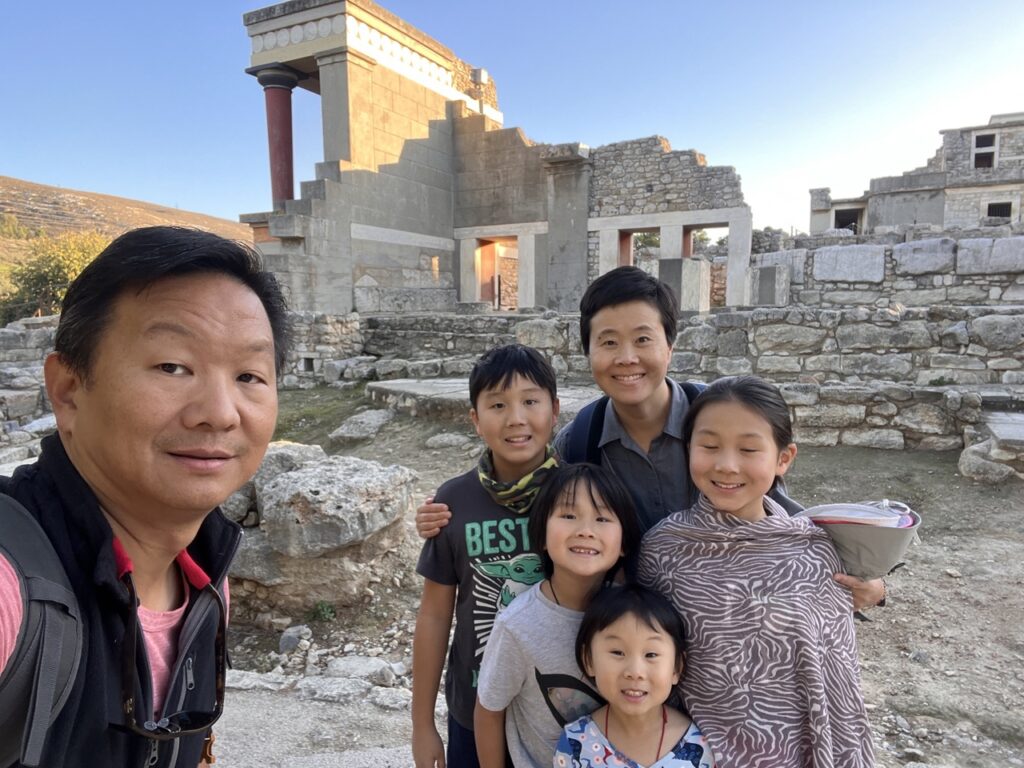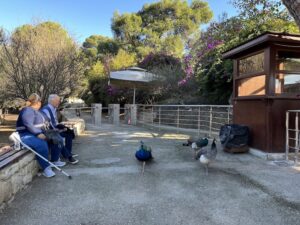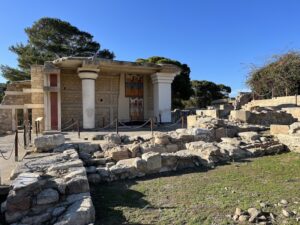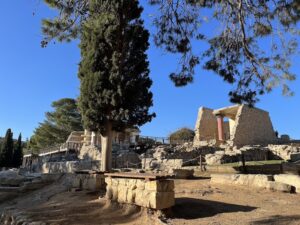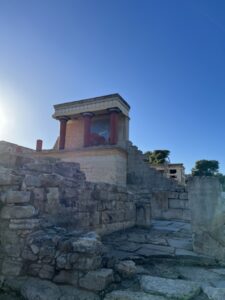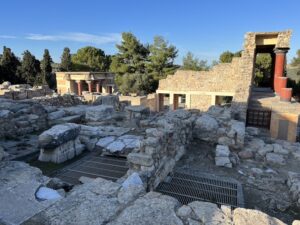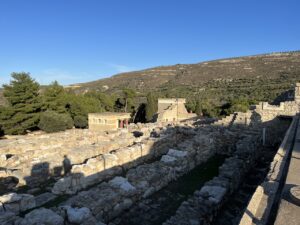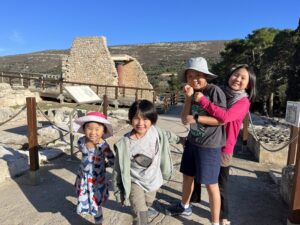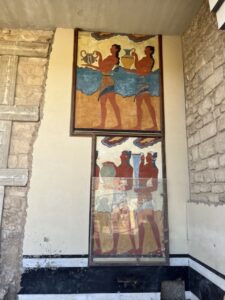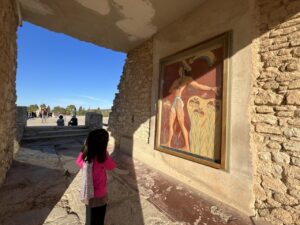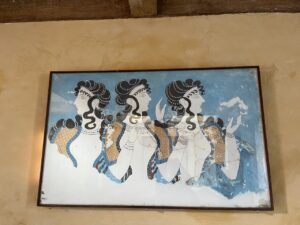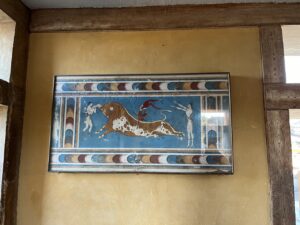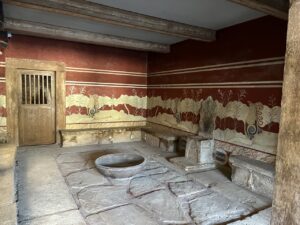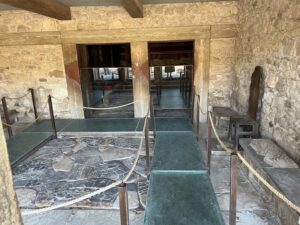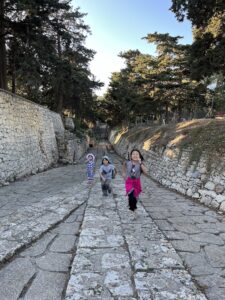Just northwest of Heraklion is the ancient city of Knossos, the epicenter for administration, trade and culture of the Minoan civilization for several hundred years in the middle of the 2nd millennium BC, during the Bronze Age. The name Knossos might sound familiar because in Greek mythology, the Palace of Knossos was where King Minos kept the Minotaur, the creature with a bull’s head and a man’s body, in a massive labyrinth built by the craftsman Daedalus and his son, Icarus.
Knossos was discovered in 1900 by Sir Arthur Evans. Excavations revealed a palace and a complex of buildings with finely crafted bronze and gold artifacts, beautiful painted frescoes and Linear A tablets that proved how sophisticated and advanced the culture was.
The earliest inhabitants of the area arrived as early as the 7th millennium BC and established an agrarian society. Over the next several thousand years, inhabitants began using Bronze and created glazed pottery. They engaged in trade with neighboring peoples including the Ancient Egyptians.
The palace that we see today includes parts of the original palace of Knossos built during the Middle Minoan period around 2000 – 1580 BC, with renovation, additions and expansions made over the next few hundred years. Before entering the site, we found a shady bench to eat our sandwich lunch and were kept entertained by a lady trying to entice a peacock to eat a cracker from her hand with loud “bok, bok, bok” chicken clucking noises.
To our surprise, the palace was unlike any other archaeological site we visited in Greece. It did not look like 3000-year-old ruins. There were parts that looked like they were constructed or painted in modern times. The colors and style of construction didn’t look like they followed the generally accepted restoration principles that Dina and other guides had explained to us and that we had observed throughout Egypt and Greece. Experts in the field believe that preserving the original ruins and retaining the authenticity of the site is of paramount importance. In general, reconstruction and renovation of an historically significant site is frowned upon. Great pains are taken to make sure any reconstruction work is as true to the original structure as possible. When we were in Athens, we visited the Stoa of Attalos within the Ancient Agora, which was reconstructed in the 1950’s. We read about debates and criticisms of the approach, but to our untrained eye, the stoa appeared beautiful nonetheless.
The reason the Palace of Knossos looked so different is because of the extensive and controversial restoration work performed by Sir Arthur Evans over a century ago. Archaeologists believe Evans designed some of the restoration work according to his own imagination. There were frescoes that had been moved from one wall to another according to Evans’ interpretation of where the frescoes belonged.
Some of the materials and techniques he used also caused damage to the site. In many areas, we observed smooth concrete steps and walkways that contrasted to the original gypsum that was in deteriorating condition, but is a unique feature of Minoan palace construction. Gypsum is a mineral that can be made to look smooth, shiny and translucent. It is related to alabaster and is used commercially as an additive in fertilizers and construction materials.
Although I understand the argument for prioritizing the integrity and authenticity of the original ruins, I have to admit the colorful frescoes and accented pillars helped laypeople like us to gain an understanding and appreciation of the appearance and purpose of the various spaces and rooms. The cement walls and floors helped to make the site easy to navigate.
We wandered through the site and saw multistoried buildings, each designed for a specific purpose. It was fascinating to see such modern-looking structures that were conceived of 4000 years ago.
There were a number of beautiful frescoes throughout the site. Some depicted Minoans in various poses and engaged in different activities. We observed that the women seemed to have white skin while the men seemed to have red or brown skin.
The most memorable mural was one depicting a man leaping over a bull in an acrobatic fashion as two women, it appeared, were helping to distract or subdue the bull.
We visited the throne room, most likely used for political or religious rituals and ceremonies.
We snapped some photos in front of the Horns of Consecration, giant bull horns that was a common symbol in Minoan religious iconography, often adorning frescoes, pottery and Minoan coffins (larnakes).
We sat down to take a break and the kids, who know far more about Greek Mythology than we do, told us the story of how the Aegean Sea got its name.
We had no idea the Minoans built the oldest road in Europe. We were tickled to have the chance to stand on and even sprint across this road, dating back to about 2000 BC. It was fascinating to imagine that around the same time as the height of the Minoan civilization at Knossos, just beyond the Mediterranean Sea, the Egyptians began construction on the temple of Karnak in Luxor.
Author
-

Song is the mother of four children. She and her family have stepped away from it all and in September 2023, began traveling the world while homeschooling. Song is an ABC (American born Chinese) and has an undergraduate degree from Cornell and an MBA from Harvard. She is an entrepreneur and an educator. Her hobbies include learning, traveling, reading, cooking and baking, and being with children.

